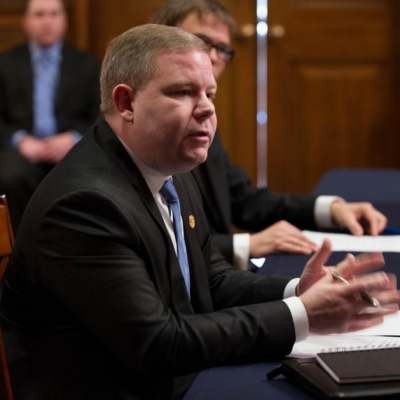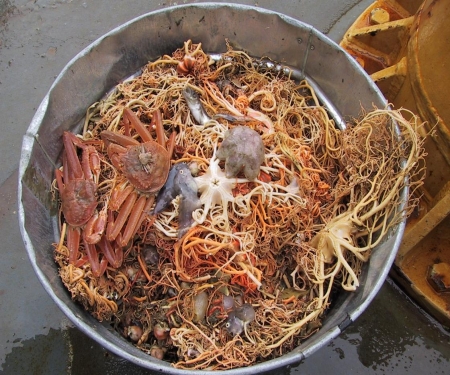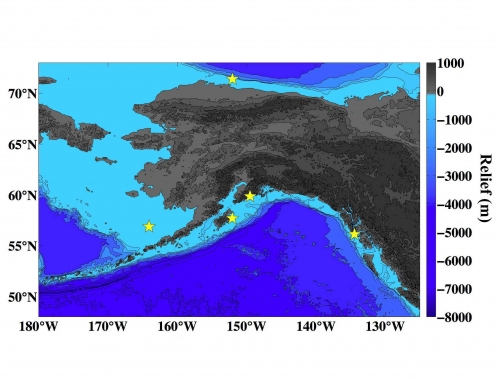By: Jeremy T. Mathis, Supervisor of Oceanography at NOAA Pacific Marine Environmental Laboratory

Since the pre-industrial era, human activities have increased atmospheric carbon dioxide (CO2) concentrations by about 40% to values near 400 ppm, which is higher than at any point during the last 800,000 years. During this rapid loading of the atmosphere, the ocean has absorbed more than 25% of the total emitted anthropogenic CO2, helping to offset atmospheric warming, but fundamentally changing ocean chemistry. The uptake of CO2 triggers a series of well-understood reactions in the surface ocean called ocean acidification (OA) that has already reduced the global surface ocean pH by about 0.1 units, making the ocean 30% more acidic than in pre-industrial times. During this process, biologically important carbonate minerals are diminished, which makes it more difficult for organisms like mollusks to create and maintain their shells, especially during early life stages.
High-latitude oceans, like those around Alaska, have naturally low carbonate ion concentrations due to low sea surface temperatures and increased solubility of CO2 and are thus considered to be more vulnerable to the impacts of OA on shorter timescales. Accordingly, the uptake of anthropogenic CO2 further reduces carbonate ion concentrations, pushing the high-latitude waters closer to the threshold where shell dissolution can occur.
Waters that are potentially corrosive to carbonate shells in the western Arctic Ocean and the Bering Sea are found in the central Canada basin, on the Chukchi and Beaufort Sea shelves, in outflow waters on the Canadian Arctic Archipelago shelf, and across the expansive northern and southern Bering Sea shelf. In the Chukchi Sea and Bering Seas, waters that are potentially corrosive to carbonate shells occur seasonally near the bottom due to the combination of natural respiration of large quantities of organic matter transported from the surface and the intrusion of anthropogenic CO2 from the atmosphere. These processes are creating an ever-expanding environment where the intensity, duration, and extent of low-pH events are increasing in one of the most productive and diverse ecosystems on Earth (see Figure 1).

While there have been few comprehensive studies, OA appears to act more strongly on certain species, but lower pH environments can fundamentally alter ecosystem composition toward dominance by non-calcifying organisms. Mollusks, such as oysters and clams, appear to be the calcifying group most negatively affected by OA. However, crustaceans such as the red king crab and tanner crab species exhibit negative responses that included slower growth and lower survival rates when they are exposed to high-CO2, lower-pH water.
Alaska's heavy dependence on marine organisms for both commercial and subsistence activities implies that ecosystem services based on these species could change as OA continues to progress. As this happens over the next 50 to 100 years, the region could be impacted through changes in food security or shifts in livelihoods. In many communities around the State, large portions of the economy are tied directly to the extraction of living marine resources. Alaska's western and southern rural areas are likely at the highest risk from OA due to a confluence of factors, including: subsistence fishing for near-shore species like clams and crabs, more rapid projected OA, lower industry diversity, economic dependence on fishery harvests, lower income, and higher food prices.
While the only way to mitigate the impacts of OA is through the reduction of CO2 emissions to the atmosphere, there are some adaptive strategies that can be implemented in the near-term to help managers and policymakers deal with any disruptions in marine ecosystem services. Careful monitoring of coastal marine environments, particularly in regions of societal and economic importance is a critical first step in addressing the challenges of OA. Beginning in 2012, a number of Federal and private agencies as well as the state of Alaska began to fund the development of an ocean acidification-monitoring network (see Figure 2) in key regions around the state.
This network is made up of fixed buoys, oceanography research cruises, and unmanned vehicles; along with a citizen-monitoring program where fisherman, school children and concerned citizens collect water in their own regions for scientific analysis. By monitoring sensitive areas and the keystone species that inhabit these environments it will be possible to detect the detrimental consequences brought on by OA before a complete collapse of a fishery occurs.

In the meantime, Alaskans, particularly those in the most vulnerable areas must work to diversify their regional economies so that they are not solely dependent on a few commercially important marine species. Alaskan commercial fisheries have a long history of opportunistically switching to different species based on availability and marketability. This suggests that the socio-economic system may have some ability to adapt to future conditions. However, every effort should be made to develop other industries and resources (e.g., fur seals, gold, timber) so that if a worse case OA scenario occurs, the consequences can be managed in a way that leaves both coastal communities and the state on sound financial footing.
For further information contact Jeremy Mathis (jeremy.mathis [at] noaa.gov).
